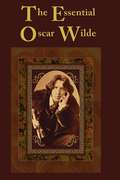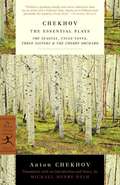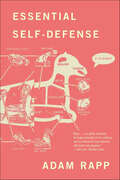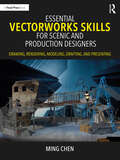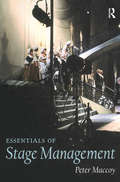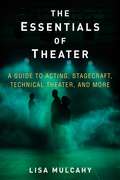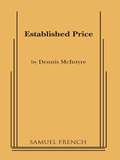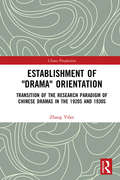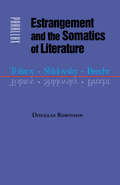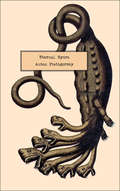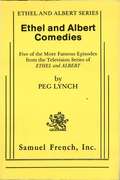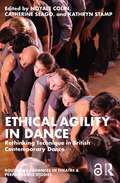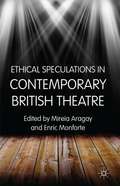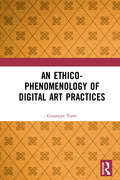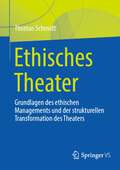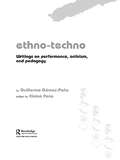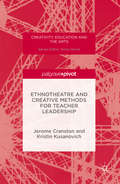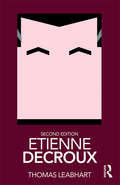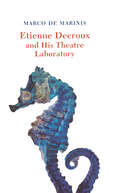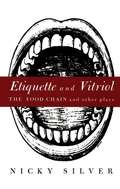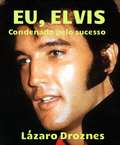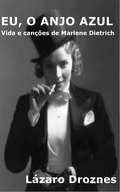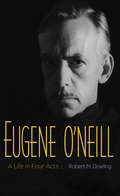- Table View
- List View
The Essential Oscar Wilde
by Oscar WildeCollected her in one omnibus edition are Oscar Wilde's most important works including The Importance of Being Earnest, The Picture of Dorian Gray, Salome, Selected Poems of Oscar Wilde, The Soul of Man Under Socialism, The Happy Prince and Other Tales, and The Canterville Ghost. These works of poetry, fiction, drama, and prose encompass Wilde's entire career and they display his range of style and wit. Wilde is one of the most important writers in the history of the English language. Wilder Publications is a green publisher. All of our books are printed to order. This reduces waste and helps us keep prices low while greatly reducing our impact on the environment.
The Essential Plays
by Anton ChekhovChekhov's four essential masterpieces for the theater: The Seagull, Uncle Vanya, Three Sisters, and The Cherry Orchard have been staged throughout the United States, Canada, and Great Britain.
Essential Self-Defense: A Play
by Adam RappThe next work for the stage from the Pulitzer finalist Adam Rapp, Essential Self-Defense.In Essential Self-Defense, disgruntled misfit Yul Carroll takes a job as an attack dummy in a women's self-defense class and finds himself mysteriously drawn to Sadie, the repressed bookworm mercilessly honing her skills on him. Meanwhile, all's not well on the unassuming Midwestern streets of Bloggs: with local children vanishing at an alarming rate, our hero, his lady friend, and a motley assortment of poets, butchers, and punk librarians prepare to battle the darkness on the edge of town.
The Essential Theatre
by Oscar G. Brockett Robert J. Ball John Fleming Andrew CarlsonThe Eighth Edition of THE ESSENTIAL THEATRE will help you get your students excited about theatre. The combined authorship of an authoritative theatre historian and his former student, an active theatre historian himself, make this the book perfect for your introductory theatre course. In the 35 years since it was first published, THE ESSENTIAL THEATRE has established a reputation as one of the most comprehensive, authoritative surveys of the theatre in academia. Now in a new full color format with many representations of current and classic performances, this text will encourage your students to become active theatergoers and fans. THE ESSENTIAL THEATRE works in tandem with its companion anthology, PLAYS FOR THEATRE. The scripts in PLAYS serve as a foundation for discussion of the various types of theatrical experience explored in the text.
Essential Vectorworks Skills for Scenic and Production Designers: Drawing, Rendering, Modeling, Drafting, and Presenting
by Ming ChenEssential Vectorworks Skills for Scenic and Production Designers is an accessible textbook that covers the digital skills of 2D drawing, 3D modeling, rendering, drafting, and design presentation, providing aspiring designers with an invaluable toolkit to quickly and efficiently hone their craft.Modeled after learner-centered teaching practice and based on USITT drafting standards, this book is structured around six carefully selected core projects. It introduces key terms and commands, tools, techniques, and procedures for drawing, modeling, rendering, drafting, and design presentation with Vectorworks. Each chapter begins with key commands and a set of learning objectives that will be explored. The design exercises and projects that follow invite the reader’s active participation in the learning process. Along with step-by-step instructions, 240 illustrations (including student work samples), and three insightful interviews with professional designers, this book also contains open-ended projects that encourage the reader to explore new ways of scenographic expression and creatively apply commands and techniques to solve example design problems.This textbook is for use in scenic design, drafting, model making, and rendering courses in university theatre and media programs, and may be of interest to emerging professional scenic designers or scenographers for theatre, opera, and concert performances, production designers or art directors in film and television industries, themed exhibition designers, and theme park designers.Essential Vectorworks Skills for Scenic and Production Designers includes access to a wealth of online resources, including 15 videos with step-by-step instruction, six files of vwx or PDF formats for additional exercises and projects, and a video of student work samples.
Essentials of Stage Management (Backstage Ser.)
by Peter MaccoyFirst Published in 2005. Routledge is an imprint of Taylor & Francis, an informa company.
The Essentials of Theater: A Guide to Acting, Stagecraft, Technical Theater, and More
by Lisa MulcahyAn Introduction to the World of Theater A friendly and practical guide to the stage, The Essentials of Theater will prepare actors and crew for their next show. Perfect for college students in theater programs, as well as community theater troupes, this book covers all the bases—from a brief history on theater over the centuries and basic terminology to tips on interpreting scripts, developing characters, and utilizing props. Lisa Mulcahy’s helpful explanations and examples take readers on a backstage tour, introducing the tasks and responsibilities of every participant: stage hands, sound designers, prop managers, and more. Special sections include: A simple guide to completing your first production project Worksheets and checklists to practice new skills Interviews with theater critics, playwrights, and sound designers Appendices with suggested readings, viewings, and resources for theater students Through real-world examples and engaging activities, readers will explore every facet of the world of theater: acting, directing, playwriting, production, technical design, and more. Mulcahy even includes a chapter on innovative ways to use one’s theater education off-stage. A great resource for college theater programs and acting classes in general, The Essentials of Theater is an excellent introduction to the stage and all of its moving parts.
Established Price
by Dennis McintyreFull Length, Comedy / 4m / Interior / This timely comedy by the author of Split Second and Modigliani is a tale of white collar angst in this age of corporate takeovers. The central character, Frank Daniels played in regional productions by both Kenneth McMillan and Jason Robards, is the former general counsel for a cannibalized corporation and he does not intend to go gently into forced retirement. He refuses to pack, tears up the office, and tries to get his fellow executives to decline their golden parachutes as a protest. / "Taut and heart felt." Philadelphia Daily News.
Establishment of "Drama" Orientation: Transition of the Research Paradigm of Chinese Dramas in the 1920s and 1930s (China Perspectives)
by Zhang YifanThe “national drama” in China is a historical concept. Grown on longstanding Chinese culture and art, the traditional drama, mainly in the form of “opera”, has been integrated with “drama” of an international background. From the perspective of modern “drama and opera”, this book mainly studies the conditions and research of Chinese traditional drama in the 1920s and 1930s. Instead of analyzing from the viewpoint of literature appreciation or music theory, the author regards the drama as a comprehensive stage art. He attaches special importance to restoring historical scenes and therefore mainly introduces the drama journals and monographs published in that historical period, in order to help readers understand the original state of drama at that time through the records of the witnesses. In particular, this book delivers an insightful view about the evolution of the meaning of “national drama” and “drama”. The book will help scholars and readers understand the meaning and the whole story of the “national drama” concept, and will certainly facilitate the construction of the discipline of Drama and Opera.
Estado Vegetal: Performance and Plant-Thinking (Art After Nature)
by Giovanni AloiInterdisciplinary essays on Manuela Infante&’s award-winning play explore the relationship between critical plant studies and performance art in the Anthropocene Since its first staging in 2016, Estado Vegetal, Manuela Infante&’s riveting piece of experimental performance art, has expanded philosophical thinking into a fully-fledged artistic inquiry of nonanthropocentric being. Through Infante&’s polyvocal monologue, acted with impetus by Marcela Salinas, plants are charged with an agency capable of uprooting culturally grounded conceptions of the world in the face of incommensurable trauma and loss. This first book dedicated to Infante&’s plant-focused performance features eight essays by scholars, poets, and artists whose practices draw from research fields as disparate as new materialism, anthropogenic feminism, queer studies, and speculative realism. Including an interview with Infante, the full playscript, and stills from the performance, Estado Vegetal: Performance and Plant-Thinking reveals the roles that plants in art can play in productively reconfiguring human–nonhuman relations within current anthropogenic perspectives. Infante&’s performance is a perfect case study and reference point for anyone interested in exploring the complexities of plant-thinking through alternative and experimental avenues. Furthermore, this book is at once a critical plant studies primer and an artistic problematization of the philosophical questions that have been central to the latest multidisciplinary discussions on plant-being. Contributors: Maaike Bleeker, Utrecht U; Lucy Cotter, Portland State U; Prudence Gibson, UNSW Sydney; Michael Marder, U of the Basque Country; Dawn Sanders, U of Gothenburg; Catriona Sandilands, York U; Sibila Sotomayor Van Rysseghem, colectivo LASTESIS; Mandy-Suzanne Wong.
Estrangement and the Somatics of Literature: Tolstoy, Shklovsky, Brecht (Parallax: Re-visions of Culture and Society)
by Douglas RobinsonDrawing together the estrangement theories of Viktor Shklovsky and Bertolt Brecht with Leo Tolstoy's theory of infection, Douglas Robinson studies the ways in which shared evaluative affect regulates both literary familiarity—convention and tradition—and modern strategies of alienation, depersonalization, and malaise.This book begins with two assumptions, both taken from Tolstoy's late aesthetic treatise What Is Art? (1898): that there is a malaise in culture, and that literature's power to "infect" readers with the moral values of the author is a possible cure for this malaise. Exploring these ideas of estrangement within the contexts of earlier, contemporary, and later critical theory, Robinson argues that Shklovsky and Brecht follow Tolstoy in their efforts to fight depersonalization by imbuing readers with the transformative guidance of collectivized feeling. Robinson's somatic approach to literature offers a powerful alternative to depersonalizing structuralist and poststructuralist theorization without simply retreating into conservative rejection and reaction.Both a comparative study of Russian and German literary-theoretical history and an insightful examination of the somatics of literature, this groundbreaking work provides a deeper understanding of how literature affects the reader and offers a new perspective on present-day problems in poststructuralist approaches to the human condition.
Eternal Hydra
by Anton PiatigorskyNominated for several Dora Awards When a young scholar finds Eternal Hydra, a long-lost, legendary and encyclopedic novel by an obscure Irish writer, she brings the manuscript to an esteemed publisher, hoping to secure an international audience for the book. But Vivian's obsession with the dead author, who has materialized in her life, is challenged by the work of a contemporary historical novelist, and she's forced to face confounding questions about authorship, racism, and ethical behavior.Weaving between modern-day New York, 1930s Paris and New Orleans in the years following the Civil War, Eternal Hydra is a postmodern look at the making of a modernist masterpiece.'A play of such tight structure, such cerebral content and such sure drama that the thoughtful theatregoer could hardly fail to be impressed.' - Globe and Mail
Ethical Agility in Dance: Rethinking Technique in British Contemporary Dance (Routledge Advances in Theatre & Performance Studies)
by Noyale Colin Catherine Seago Kathryn StampThis edited collection examines the potential of dance training for developing socially engaged individuals capable of forging ethical human relations for an ever-changing world and in turn frames dance as a fundamental part of human experience. This volume draws together a range of critical voices to reflect the inclusive potential of dance. The contributions offer perspectives on contemporary dance training in Britain from dance educators, scholars, practitioners and artists. Through examining the politics, values and ethics of learning dance today, this book argues for the need of a re-assessment of the evolving practices in dance training and techniques. Key questions address how the concept of ‘technique’ and associated systems of training in dance could be redefined to enable the collaboration of skills and application of ideas necessary to twenty-first-century dance. The editors present these ideas in different modes of writing. This collection of essays, conversations and manifestos offers a way to explore, debate and grasp the shifting values of contemporary dance. Examining these values in the applied field of dance reveals a complex and contrasting range of ideas, encompassing broad themes including the relationships between individuality and collectivity, rigour and creativity, and virtuosity and inclusivity. This volume points to ethical techniques as providing a way of navigating these contrasting values in dance. It serves as an invaluable resource for academics as well as practitioners and students.
Ethical Speculations in Contemporary British Theatre
by Mireia Aragay Enric MonforteThis volume is the first to offer a comprehensive critical examination of the intersections between contemporary ethical thought and post-1989 British playwriting. Its coverage of a large number of plays and playwrights, international range of contributors and original argumentation make it a key point of reference for students and researchers.
An Ethico-Phenomenology of Digital Art Practices
by Giuseppe TorreDigital art practitioners work under the constant threat of a medium – the digital – that objectifies the self and depersonalises artistic identities. If digital technology is a pharmakon in that it can be either cure or poison, with regard to digital art practices the digital may have in fact worked as a placebo that has allowed us to push back the date in which the crisis between digital and art will be given serious thought. This book is hence concerned with an analysis of such a relationship and proposes their rethinking in terms of an ethico-phenomenological practice informed by an in-depth understanding of the digital medium. Giuseppe Torre engages with underground cultures such as Free and Libre Open Source Software (FLOSS) and its ties with art discourse. The discussion is informed by various philosophical discourses and media theories, with a focus on how such ideas connect back to the existing literature in performance studies. Replete with examples of artwork and practices, this book will be of great interest to students and scholars of theatre and performance studies, art and technology.
Ethisches Theater: Grundlagen des ethischen Managements und der strukturellen Transformation des Theaters
by Thomas SchmidtMit dem Konzept des Ethischen Theaters wird ein ganzheitliches Zukunftsmodell vorgestellt. Ausgangspunkt ist die Analyse der gegenwärtigen Krisen und der Komplexität in den deutschsprachigen Theatern, um die Grundlagen für ihren Transformationsprozess zu entwickeln. Mit dem Ethischen Theater wird ein Ziel dieses Prozesses vorgestellt: das ganzheitliches Zukunftsmodell einer Theater-Organisation des 21. Jahrhunderts, in der ethische Überlegungen erstmals in allen Prozessen handlungsleitend sind. Das Modell ist kompatibel mit den Interessen der Stakeholder und den wichtigen Reformprozessen, es ermöglicht die anstehende strukturelle Modernisierung der Theaterbetriebe. Unterstützt wird es durch das Konzept des Ethischen Theatermanagements, das erstmals über die klassischen Funktionen hinaus auch Aspekte der Diversität, der Nachhaltigkeit, der Ethik und der Zukunftsfähigkeit adressiert. Mit den erweiterten Funktionen des ethischen Managements werden auch weitere Möglichkeitsräume für die Zukunft der Kultur-Organisationen eröffnet.
Ethno-Techno: Writings on Performance, Activism and Pedagogy
by Guillermo Gomez-PenaGuillermo Gómez-Peña has spent many years developing his unique style of performance-activism; his theatricalizations of postcolonial theory. In Ethno-Techno: Writings on Performance, Activism and Pedagogy, he pushes the boundaries still further, exploring what's left for artists to do in a post-9/11 repressive culture of what he calls 'the mainstream bizarre'.Over forty-five photos document his artistic experiments and the text not only explores and confronts his political and philosophical parameters; it offers groundbreaking insights into his, and his company's, methods of production, development and teaching.The result is an extraordinary and inspiring glimpse into the life and work of one of the most daring, innovative and challenging performance artists of our age.
Ethnotheatre and Creative Methods for Teacher Leadership
by Jerome Cranston Kristin KusanovichThis book addresses the lived challenges to teacher leadership. It illustrates an arts-based research approach that effectively highlights the broader context of relational dynamics between adults at school, using one-act plays to open up difficult conversations on complex issues. School leadership has, ostensibly, a performative dimension. Teacher leaders enact leadership from a more vulnerable platform than those with administrative positions, while they try to thrive in roles which are not always clear from their pre-service preparation. Early-career teachers are often not aware of the very real hazards that can accompany their initial foray into leadership. This book encourages creative thinking about how to enact the teacher role to better embed and advocate for a supportive and just system.
Etienne Decroux (Routledge Performance Practitioners)
by Thomas LeabhartEtienne Decroux is the primary creator of Corporeal Mime and one of modern theatre’s most charismatic innovators, known for his ground-breaking use of the body as the principal means of expression on stage. This second edition combines: an overview of Decroux’s life and work an analysis of Decroux’s Words on Mime, the first book to be written about this art a series of practical exercises offering an introduction to Corporeal Mime technique. As a first step towards critical understanding, and as an initial exploration before going on to further, primary research, Routledge Performance Practitioners are unbeatable value for today’s student.
Etienne Decroux and his Theatre Laboratory (Routledge Icarus Ser.)
by Marco de MarinisEtienne Decroux and His Theatre Laboratory is based on the long-awaited translation of Marco De Marinis' monumental work on mime in the twentieth century: Mimo e teatro nel Novecento (1993). Now revised and updated, the volume focuses specifically on the seminal role played by French mime artist and pedagogue Etienne Decroux. Mime is a theatrical form of ancient tradition. In the nineteenth century, it saw both apogee and crisis in the west with the realistic and gesticulating 'white pantomime'. In the twentieth century, it underwent a radical overhaul, transforming into an 'abstract' corporeal art that shunned imitation and narrative, and which instead tended towards the plastic, elliptic, allusive, and symbolic transposition of actions and situations. This book is the result of detailed investigations, based on contemporary accounts and obscure or unpublished materials. Through the examination of the creative, pedagogical, and theoretical work of the 'inventor' of the new mime art, Etienne Decroux, De Marinis focuses on the different assumptions underlying the various modes of the problematic presence of mime in the theatre of the twentieth century: from the utopia of a 'pure' theatre, attributed to the sole essence of the actor, to its decline into a closed poetic genre often nostalgically stuck in the past; from mime as a pedagogical tool for the actor to mime as an expressive and virtuosic means in the hands of the director.
Etiquette and Vitriol
by Nicky SilverThis collection brings together two of Silver's highly acclaimed and successful works, the long-running Off Broadway hit The Food Chain and Pterodactyls, with two of his earlier works, Fat Men in Skirts and Free Will and Wanton Lust.
Eu, Elvis: Condenado pelo sucesso.
by Lázaro Droznes Danilo Aguilar MirandaA trajetória de Elvis Presley é a trágica história de uma celebridade, vítima do próprio sucesso e das circunstâncias. Os adolescentes sonham em ser estrelas do rock, e Elvis se pergunta: "Com o que podem sonhar as estrelas do rock?". Com 23 anos de idade, Elvis já tinha conseguido muito mais do que havia sonhado em suas mais loucas fantasias, mas pouco depois se converte em prisioneiro de sua própria imagem, sentindo que sua vida já não lhe pertencia. Preso em um labirinto que ele mesmo havia construído. Esta obra de ficção recria os momentos mais significativos da vida do ídolo através de histórias curiosas e de suas canções, para revelar a sequência de circunstâncias que levaram uma celebridade a pagar o preço da fama com sua própria vida.
EU, O ANJO AZUL
by Lázaro Droznes Anabela Alves Lopes Afonso Romão PintoDescrição do livro: Marlene Dietrich foi uma das grandes estrelas de cinema de Hollywood e um dos grandes mitos do cinema. Nascida na Alemanha, descoberta por Josef von Sternberg, emigrada nos Estados Unidos e depois nacionalizada norte-americana, transformou-se num ícone da sedução, da mulher fatal e do eterno feminino. Além disso, a sua intensa militância contra o nazismo e a sua participação como soldado na Segunda Guerra Mundial revelam um aspeto insuspeito da sua personalidade. Nesta obra, Marlene revela episódios e experiências íntimas da sua vida lendária, intercaladas com as famosas canções que ilustram a sua vida, tanto como o fazem as suas histórias de vida. Qual é o mistério que oculta e revela Marlene Dietrich?
Eugene O'Neill: A Life in Four Acts (American Critical Archives Ser.)
by Robert M. DowlingAn &“absorbing&” biography of the playwright and Nobel laureate that &“unflinchingly explores the darkness that dominated O&’Neill&’s life&” (Publishers Weekly). This extraordinary biography fully captures the intimacies of Eugene O&’Neill&’s tumultuous life and the profound impact of his work on American drama, innovatively highlighting how the stories he told for the stage interweave with his actual life stories as well as the culture and history of his time. Much is new in this extensively researched book: connections between O&’Neill&’s plays and his political and philosophical worldview; insights into his Irish American upbringing and lifelong torment over losing faith in God; his vital role in African American cultural history; unpublished photographs, including a unique offstage picture of him with his lover Louise Bryant; new evidence of O&’Neill&’s desire to become a novelist and what this reveals about his unique dramatic voice; and a startling revelation about the release of Long Day&’s Journey Into Night in defiance of his explicit instructions. This biography is also the first to discuss O&’Neill&’s lost play Exorcism (a single copy of which was only recently recovered), a dramatization of his own suicide attempt. Written with both a lively informality and a scholar&’s strict accuracy, Eugene O&’Neill: A Life in Four Acts is a biography worthy of America&’s foremost playwright. &“Fast-paced, highly readable . . . building to a devastating last act.&” —Irish Times
